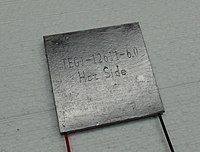
Photo from wikipedia
Abstract Bi-Sb-Te thin films on SiO2/Si-wafer substrate were prepared by a magnetron co-sputtering process using Bi2Te3 (fixed: 50W) and Sb2Te3 (varied: 10, 15, 20 and 50W) targets. All as-deposited thin… Click to show full abstract
Abstract Bi-Sb-Te thin films on SiO2/Si-wafer substrate were prepared by a magnetron co-sputtering process using Bi2Te3 (fixed: 50W) and Sb2Te3 (varied: 10, 15, 20 and 50W) targets. All as-deposited thin films were annealed by rapid thermal annealing (RTA) at 250°C under a vacuum state with a step of heating and holding each for 1 min. The effect of the RTA process onto thin film samples studied concerning the crystal structure, morphology, thickness, composition, and electrical and thermoelectric properties. The crystal structure of annealed samples showed the c-axis preferred orientation with the (00 l) plane (l = 15) and revealed a trend of p-type thermoelectricity behavior due to the RTA process. The annealed thin film compositions were BiTe, Bi0.92Sb0.08Te, Bi0.9Sb0.1Te, Bi0.88Sb0.12Te, and Sb2Te3. The Bi0.9Sb0.1Te thin film composition had the maximum power factor of 4.46 mW m–1 K–2 at a temperature of 100 °C.
Journal Title: Thin Solid Films
Year Published: 2020
Link to full text (if available)
Share on Social Media: Sign Up to like & get
recommendations!